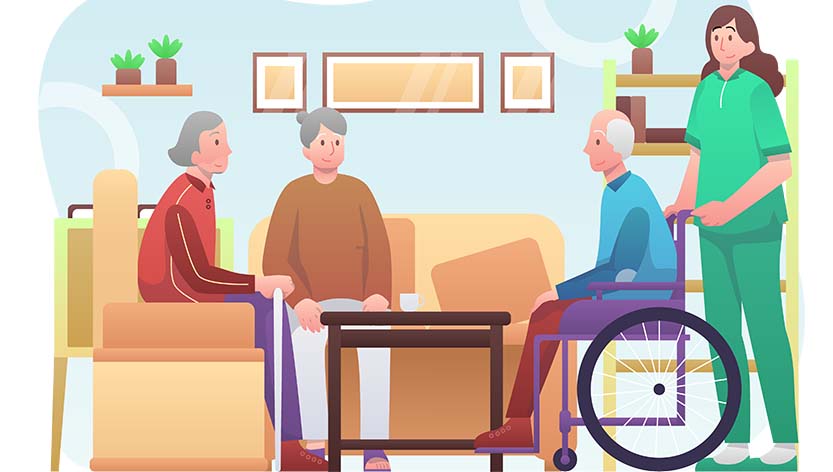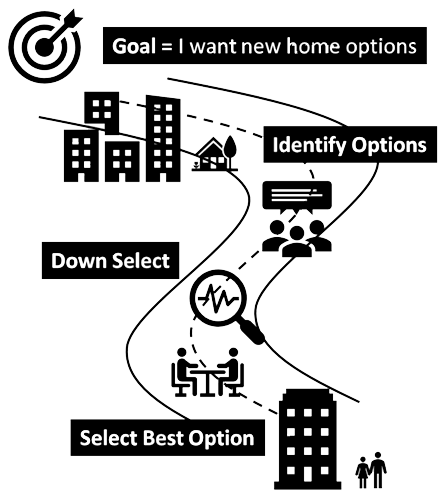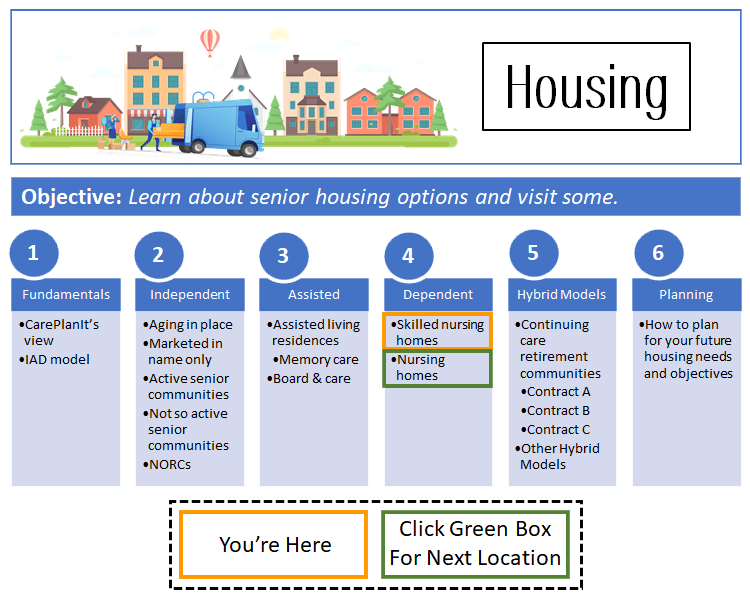Skilled Nursing Homes – How To Choose
Click here to see what's on this page.
Consider skilled nursing homes and nursing homes synonymous. Most nursing homes today are skilled nursing homes. This level of certification allows the facility to offer more services. In other words, they have the right staff and operating procedures to qualify for Medicare and Medicaid reimbursement.

Skilled nursing facilities (SNF’s – pronounced SNIFFS) provide “skilled nursing care.” Skilled professionals like nurses and physical therapists provide skilled care. Examples of skilled care include intravenous injections and physical therapy.
Most Seniors Fear Skilled Nursing Homes
Dependent living facilities (aka Nursing Homes) are the stuff of our nightmares. Zombie residents in wheelchairs staring off into the distance. They smell of urine or powerful disinfectants. These images are hard to get out of our heads and the reason so many seniors plead with their spouses and children to never put them in a nursing home. It’s always wise to find a great nursing home in your area and visit. This can help partially alleviate the nightmares.
How do we address these fears? The best way is to spend some time in a well-managed skilled nursing facility. It turns out this isn’t that hard because most seniors will have multiple hospitalizations. As a result, most of these seniors will have an opportunity for Medicare rehabilitation services. More often than not, these services can be received in a skilled nursing home (often called a rehabilitation center). In other words, seniors can spend some time in nearby nursing homes as they recover from hospital stays. If you know of a few good ones in your area, those are the ones to visit. While there, you (or your loved one) get a sense of what the facility is all about. Also, most seniors recover and go home. For that reason alone, the skilled nursing home has at least one positive outcome: a feather in the SNF’s hat.
Licensing Of Skilled Nursing Homes
Because the government pays for skilled care, they require proper licensing of nursing homes. Licensure for skilled nursing opens up more service offerings and revenue opportunities. For example, one of the more profitable revenue streams of SNFs is rehabilitative care services. Think rehabilitation after a hospital discharge. Services to help you regain strength and perform daily tasks.
Staff Providing Medical Care Is Licensed
In order to qualify as a skilled nursing facility, you need skilled employees. These employees have titles like:
- Registered nurses,
- Licensed practical and vocational nurses,
- Physical and occupational therapists,
- Speech-language pathologists, and
- Audiologists.
You get skilled nursing care to:
- Help improve your condition, or
- Maintain your current condition and prevent it from getting worse.
In addition, you get skilled rehabilitation care for the following:
- Help improve your condition within a predetermined time period, or
- Set up a maintenance program designed to maintain your current condition and prevent it from getting worse.
As a result, skilled care helps you get better, function more independently, and learn to care for your health needs. Moreover, you and your family will be able to take part in setting your health goal.
How To Find Skilled Nursing Homes Near Me
Type nursing homes near me into Google, and thousands of listings come back. It’s easy to be overwhelmed. Don’t panic. You’ve found CarePlanIt. We help you find the best skilled nursing homes options nearby, cross-town, or in another state. You’ve got this if you do the following:
We’ve discussed the senior housing journey many times. See the diagram below.

Make Sure You’ve Set The Right Goal
CraePlanIt always recommends your projects start with the right goal. For example, your goal is bad if you or your loved one isn’t interested in looking at a new housing option. The “project” of finding the right senior home is likely to fail. The reason is simple. The senior isn’t on board. The first “project” is to get the senior on board. You might start with going through our section on Senior Housing – Make It Easy. You have the right goal when you or you’re loved one agrees it’s time to look for new housing options.
Identifying Options
Skilled nursing home searches are complicated. No one really wants to be in one. If you don’t have experience with nursing homes first reactions are almost always negative. So there is a kind of art is initiating your search.
Quick tip:
If you’re religious, start with your church, parish, temple, or mosque. See what long-term care facilities they may be involved with, or recommend. Most large congregations deal with senior housing issues on a regular basis. Find their expert and seek advice.
Generally, you’re going to find options using some or all the options below.
See CarePlanIt’s How To Find The Best Assisted Living Near Me
We cover the details of how to select assisted living housing options here. In this section, we tell you about the three categories people use to find senior housing options.
Downselecting
Once you have identified ten or more facilities, you’ll need to downselect. For our purposes, downselecting is reducing your choices of facilities you want to visit. It’s hard to visit ten or twenty facilities. You might have to if your initial downselects don’t work out, but the goal is to find the best options for site visits. Once you have five or ten skilled nursing homes identified it’s time to narrow the group for site visits. We recommend two ways. Firstly, go back to your trusted sources and ask them to rank the facilities on your list. Secondly, use the government’s five how Skilled nursing homes are easy to compare.
Revisit Trusted Sources
Go back to your trusted sources (e.g., friends, doctors, senior case managers, religious contacts, etc.) and ask them to rank your list. They’ve already given you their best options. So your asking them to rank what you’ve downselected.
Compare The Quality Of Skilled Nursing Homes
Through its Medicare and Medicaid programs, the government collects reams of data from skilled nursing homes. All that data is available to you. The government also combines that data into a rating system.
They’ve developed a five-star rating system based on health inspections, quality measures, and staff ratings. This is the best place to help narrow down your choices. Their website is here. But learn about these three key categories below.
Health Inspection Rating
All nursing homes receiving Medicare or Medicaid payments must participate in onsite certification programs. These include inspections and occur about once a year. They provide a comprehensive assessment of the nursing home. The examination also reviews the facilities’ practices and policies, including medication management, skincare, quality of life, resident rights, resident assessments, administration, food services, general administration, and kitchen safety.
Ratings are based on nursing home surveys, complaint surveys, and revisits over the past three years. Points are assigned by the number and scope of deficiencies. Lower points are better. Homes within a state are grouped, and facilities are ranked against other facilities in their state. The top 10% of nursing homes get five stars, the bottom 20% get 1 star. The middle 70% get places in one of three tiers of star categories, 2, 3, or 4 in 23.3% proportions.
Quality Measure Ratings
Quality measures (QMs) are based on 10 measures. These are divided into long-stay and short-stay QMs. Data points come from reimbursement requests and minimum data sets (MDS). Long-stay QMs look at the percentage of long-stay residents whose need for help with activities of daily living has increased, percentage of residents whose ability to move independently worsened, percentage of residents with pressure ulcers, percentage of residents that have had a catheter inserted in their bladder, percentage of residents with urinary tract infections, percentage of residents experiencing one or more falls with a major injury, percentage of residents taking antipsychotic medications. Long-stay measures derived from claims data look at the number of hospitalizations per 1,000 long-stay residents and number of outpatient emergency department visits per 1,000 long-stay residents
Short-stay measures from MDS examine the percentage of residents re-hospitalized after a nursing home admission, percentage of residents requiring an outpatient visit to the emergency department (ED), and successful return rate (home or community) from a SNF.
Staff Ratings
Studies consistently show a high correlation between nursing home staff levels and positive resident outcomes. In other words, more trained staff results in a better quality of care. The staff ratings are based on tracking two nurse staff measures and total staff.
Staff rating scores and created by combining RN and total nurse staffing ratings.
Selecting The Best Option – Site Visits
Site visits are critical to select a skilled nursing facility. We have a comprehensive premium content guider here. We also have additional details in our section called How To Evaluate Nursing Homes.
